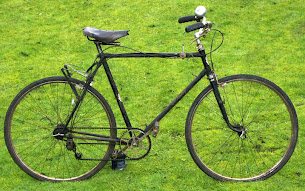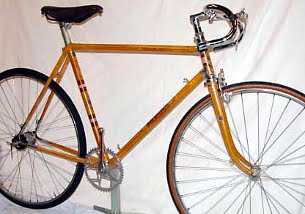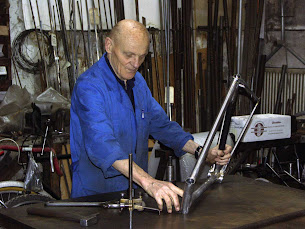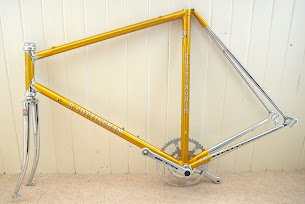If you're a vintage vehicle enthusiast, whether bicycles, motor bikes or cars, the "barn find" is the holy grail. A machine not widely known, not on the market and in danger of being lost forever without your intervention. There are plenty of Youtube videos where cars left to languish at the back of a barn for more than 30 years have suddenly come to light, usually when the owner who left it there dies.
Such a barn find was this 1948 Hobbs of Barbican bike, the pinnacle of post-war racing machines. Happily, the owner is still very much alive and kicking although now approaching 90. As a vintage racing bike enthusiast, I found out about this particular bike when I bought a 1936 lightweight from the owner's older - and now deceased - brother. The older brother told me his younger sibling had a pre-war Hobbs so I got the phone number and gave the chap a ring. That was about 12 years ago.
The Hobbs, I discovered, was at the back of an outbuilding in the countryside and the old lad assured me that, although he couldn't reach the bike for all the clutter, he would get round to clearing the building out. He suggested I phone back in a few months. I did call him back - around three times a year, every year for a dozen years.
In January of this year, I gave him a call and he told me to phone back in a couple of months since he and a friend were going to tackle the outbuilding clearance. When I called again, the owner was recovering from a mild stroke, if there is such a thing when you're approaching 90. At that point I was inclined to forget it as I didn't want to bother the old guy unduly but he told me to phone in the summer.
Well, before I could do so, I got a call from him to say the bike had now been recovered from its resting place of 30 years and I was welcome to have a look at it.
 |
| It was quite common back in the day for one of the head lugs - usually the lower one - to have a grease nipple for ease of lubrication. This Hobbs has two. |
He wouldn't take anything for it but asked that I make a donation to charity and that's how I became the new owner of a Hobbs' top-of-the-range Superbe model. In its day, this bike was the equivalent of those machines they used in the Tour de France today. The owner bought the frame secondhand but couldn't remember which year. He built it up using new parts which were clearly from the late 1940s.
I had hoped the Hobbs was a pre-war frame but the frame number revealed it had been made in October, 1948, so it must have been quite new when it was put together in it's present configuration.
You don't have to be a bike collector to see that the Hobbs needs a massive amount of restoration. The wheel rims are beyond salvation.
The hubs, although still spinning smoothly, are in a similar condition with their chrome finish all gone. In fact, a quick way of saying it is that everything steel is rusty and everything aluminium is corroded.
The hubs, although still spinning smoothly, are in a similar condition with their chrome finish all gone. In fact, a quick way of saying it is that everything steel is rusty and everything aluminium is corroded.
I'm not too bothered about the alloy parts as they can usually be brought back to life but the wheels are toast and the Boa pedals marginal at best. The chain set was made by Chater Lea - hence the CL on the chain ring - and could be rechromed at reasonable cost.
The pedals can also be replated but hammered rivet joints have to be filed away so the pedals can be dismantled and all parts be polished prior to going in the chrome bath - and that's quite a lot of work.
 |
| Constrictor Boa pedals and Chater Lea chainset. They don't make names like those any more! |
 |
| Fancy lugs and red lug and "box" lining - lovely! |
 |
| Reynolds 531 tubing transfer: a sign of quality. And more fancy brush work. |
Oddly, the bike's transfers have survived rather well but there are parts of the frame where the paint has flaked off and some light rust taken hold and that's a concern. I'll use my usual trick of rubbing these rusty areas with scrunched up tin foil and WD40 as a lubricant and then see how it looks. In the same way that I much prefer old cameras to new ones, I also love old bikes and have zero interest in modern carbon fibre machines.
As a company, Hobbs of Barbican was only on the go for around twenty years but there's a rich history associated with the firm and I can relate to all of it. What I can't relate to is the idea of frames being built by people in Chinese sweatshops on a dollar a day, being quickly and garishly branded and then sold with an enormous mark-up. Will anyone collect these monstrosities in future?
I doubt it. It also helps that my late dad's lightweight racer was a late-1940s Hobbs bought when he was around 25. It was his cycling stories when I was a boy that sparked my interest in old bikes and Hobbs in particular. My collecting started when I set out to find a Hobbs just like his and now I have one.
 |
| Celluloid mudguards still hanging on 66 years later. They need a small repair but are otherwise still serviceable. |
 |
| Lucas "King of the Road" bell, big Miller lamp and GB (after Gerry Burgess who started the company) brakes. All set for the road - or will be with a lot of work! |





